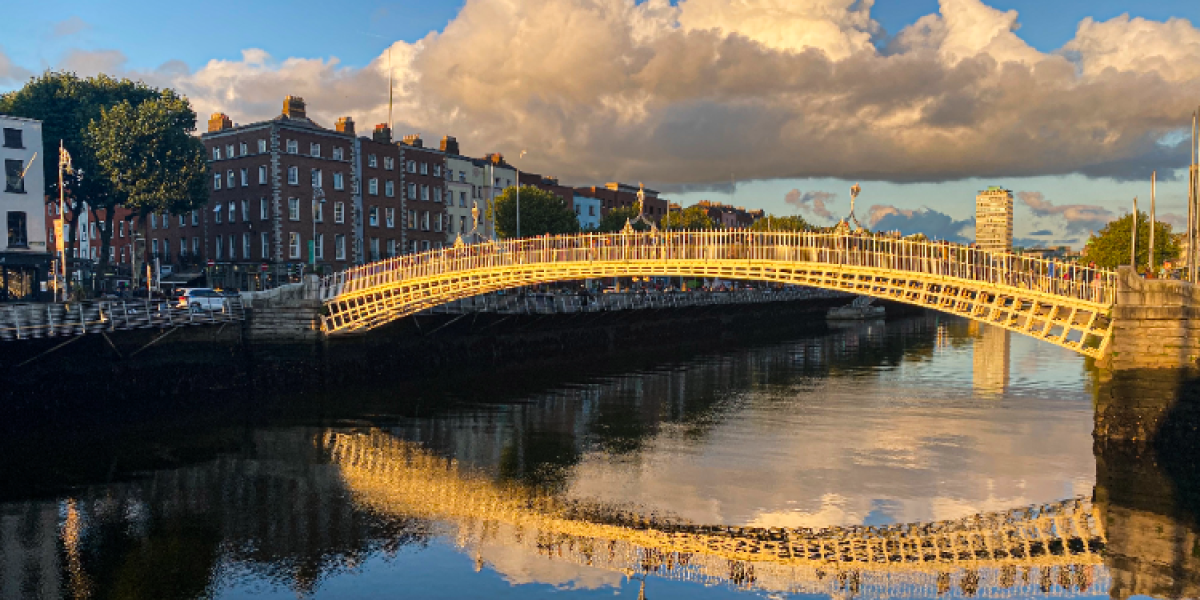
If you are thinking about moving to Dublin, you may have your own expectations and preconceptions based on what you have heard from other people or read online, but these expectations are not always going to be the reality. Cities can change in just a few years, and websites often don't get updated. Therefore, you need to have up-to-date information from people on the ground. This guide shows you what it is really like to live in Dublin.
Climate in Dublin
The Irish have a love affair with discussing the weather. The weather is always a topic of conversation, as it can change in an instant and is notoriously unpredictable. It can be sunny, raining, or a mixture of both at any point in the day. So much so that it has often been said that in Ireland, “you get all four seasons in one day”.
The climate in Ireland rarely tends to go from one extreme to the other. It is generally consistently mild, with the average temperature in the winter rarely falling below freezing point. In the summer, the maximum temperature will rarely rise above 26°C and will generally average at around the 15°C mark. This is because Ireland lies in the Atlantic Ocean, and as a result is warmed by the Gulf Stream all year.
Although heavy snow in the winter is rare, January and February are the months in which it is most frequent, and there is generally abundant rainfall throughout the year. The weather is generally better on the east of the country, and Dublin usually has less rain than other cities. The warmest months of the year are July and August. It will stay bright late, with the sun usually not setting until 11 pm.
Social life in Dublin
Irish people are generally very friendly and welcoming, and the world-renowned “céad míle fáilte” is a common greeting in Ireland, translated as a hundred thousand welcomes.
Dublin is famous for its nightlife, and pub culture is a quintessential part of life. Irish people love a drink, and they like to spend their weekends socialising with friends in pubs and bars around the city. The pub is one of the main areas of socialising, where people gather for a social drink and the famous “craic agus ceoil” Ireland has become renowned for.
However, Dublin's pubs are much more than places to eat and drink. People gather to share stories, enjoy traditional Irish music, and partake in a hearty meal. Dublin is home to over 770 pubs and is a hive of activity at night, regardless of the day of the week. With so many great bars to choose from, from traditional pubs to upmarket and trendy bars or nightclubs, there is something for all tastes.
There are plenty of live music venues in the city, including the world-famous Whelan's on Camden Street. There are always great comedy gigs taking place in Dublin, with the Laughter Lounge being a favourite, where many of the top Irish and international comedians perform.
The 3 Arena plays host to concerts from global musicians and bands. The weekends are always buzzing around the city, so you never know what event or festival will be taking place on the streets. During the summer months, you are spoilt for choice with the music festivals in and around Dublin. Many major global acts come to perform every year, and it is a great way to unwind at the weekends.
Good to know:
If you enjoy the bar and pub scene, it's recommended that you avoid the Temple Bar area, which has become a tourist trap in recent years.
Nature in Dublin
Ireland is known for its green fields and rocky coastline. In Dublin city centre itself, you can go for beautiful nature walks in any of the many parks, such as Phoenix Park, St Stephen's Green, and Merrion Square, to take a breather from the hectic city life.
St. Stephen's Green, located in the centre of the city, is one of the city's most-loved parks, and with its stunning gardens and bandstands, it's a great spot for a leisurely tree-lined stroll or some people watching.
Phoenix Park is only a stone's throw from the city centre. It is the largest enclosed city park in Europe and the second largest in the world. It is home to not just herds of wild deer, but also the President of Ireland, who lives in Áras an Uachtaràin. You can also visit Dublin Zoo.
As Dublin is located right beside the Irish Sea, there are a lot of great walks and epic scenery in and around the city, such as the Poolbeg Pier, and along the coast by Dun Laoghaire, Greystones, and Bray, where there are breathtaking views of the sea. And for the more adventurous, you can take in the majestic scenery on a hike in the Dublin mountains.
Cost of living in Dublin
Dublin currently lies ninth in the top rankings of the most expensive cities in Europe to live in. This is mainly driven by rental expenses; the average rent in Dublin is over €2,300 a month. The cost to buy or rent a house is at an all-time high and day to day expenses are also rising due to soaring inflation.
Renting in Dublin is so exorbitant and competitive that many expats and digital nomads look to nearby areas, including Drumcondra, Maynooth, and Skerries, as more affordable alternatives. Keep in mind that the closer you live to public transportation, the more rent you can expect to pay.
Dining out in Dublin is expensive, and for a three-course meal in a mid-range restaurant, you can expect to pay between €70 to €100 for two.
Utility bills, such as heating, gas, and electricity, cost on average €200 a month, and you can expect to pay between €40 and €60 for broadband. Generally, you will be looking at paying €30-€70 a month for a gym membership. This will rise for higher-end gyms, with the Westwood Gym in Dublin costing approximately €80 a month.
The estimated total cost of living for a single person in Dublin is between €2,000 to €3,500 a month.
How to adjust to the local etiquette in Dublin
Ireland's local culture and customs come with their own set of norms and nuances. Therefore, it is a good idea to familiarise yourself with the etiquette in your new city.
Irish people are renowned all over the world for being friendly. When you are out walking, passers-by will often nod, smile or say hello to you. They will usually help give you directions or advice if you stop and ask them nicely. When you meet someone for the first time, extend a firm handshake and always make eye contact.
Irish people are reserved when it comes to displays of public affection, such as hugging and kissing with people they do not know. Hugs and kisses are usually reserved for family members and good friends.
Irish people are legendary for their love of conversation, witty banter, and, of course, the legendary gift of the gab. Sitting at the counter of your local bar, standing in line at the supermarket, or travelling on a bus, you'll find people are happy to strike up a conversation with you about any topic under the sun. Chatting with strangers is a common practice in Ireland. If you can't think of anything to say, you can always talk about the weather, as the Irish love weather chats.
Never criticise the country or its culture. While Irish people are generally easy-going, they are very patriotic and do not like to hear others saying negative things about their country.
Irish people aren't the best at timekeeping. If they say they will be somewhere in five minutes, it usually means twenty minutes. While Irish people have a great work ethic, they are not always the most punctual.
Irish people generally are a lot more easy-going when it comes to swearing. They have a propensity towards swearing, and the younger generation in particular use swear words casually, which can often be a sign of endearment or banter.
Take a walk through Dublin city, and, as mentioned above, there will be more pubs per square foot than anything else. Pubs are meeting places and the hub of cultural activity. Alcohol plays a huge part in Irish social etiquette, and it is customary for everyone to buy a “round of drinks” when in a group setting. It is frowned upon to buy a drink just for yourself when in a group. Turning down an offer of a drink from someone can also be seen as an insult.
When it comes to tipping in Dublin, some restaurants have a service charge included in the price. Otherwise, if you get good service, it's customary to leave a tip of 10% of the bill.
We do our best to provide accurate and up to date information. However, if you have noticed any inaccuracies in this article, please let us know in the comments section below.








